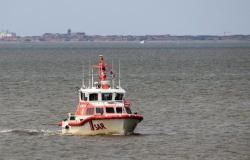Why did the Boeing 737 F crash in Vilnius? The suspicion quickly arose that it could have been an attack. But the Lithuanian authorities gave the all-clear. They look elsewhere.
It could have ended in disaster. But according to current information, only one person died in the crash of Swiftair’s Boeing 737-400 SF in Vilnius. Lithuanian authorities reported the death of a pilot. He was a Spanish citizen. The second pilot and the two other crew members – men with Lithuanian, German and Spanish passports – survived injured.
The Boeing 737 with the registration EC-MFE from Swiftair took off from Leipzig on Monday morning (November 25th) on behalf of DHL. She was on approach to runway 19 at Vilnius Airport shortly before half past five in the morning. But it crashed about 1.6 kilometers short of the runway. Apparently the conversion freighter first skidded along the ground and then crashed into a two-story residential building near the airport where 14 people lived.
Well below ILS glide path
As the Aviation Herald portal, which specializes in incidents, reports, Swiftair’s Boeing 737 was around 26 meters below the glide path at an altitude of around 77 meters during the ILS approach to the runway – so it was flying too low. Footage from a webcam shows the plane flying QY-5960 very low over trees and houses and then suddenly tilting to the left. However, this information has not yet been confirmed.
But there is at least some evidence that an error occurred for some reason. The Lithuanian authorities had already stated in an initial statement that they were investigating technical or human errors. But they hadn’t ruled out anything at first, including the possibility of a terrorist act.
Probably no external influence
But on Monday afternoon, Police Commissioner Arūnas Paulauskas said there was no evidence of external influence. «The initial assessment is that the plane did not crash but landed, and there is no visible evidence of external damage. According to the initial information, there is no evidence that anything happened inside the aircraft,” the Delfi portal quoted him as saying. There was no fire or smoke on board.
The terrorist act hypothesis also arose because incendiary devices were found in DHL distribution centers in Leipzig and Birmingham in the summer. They had been abandoned in Lithuania and were headed for North America. The assassination attempts were attributed to Russian saboteurs.






